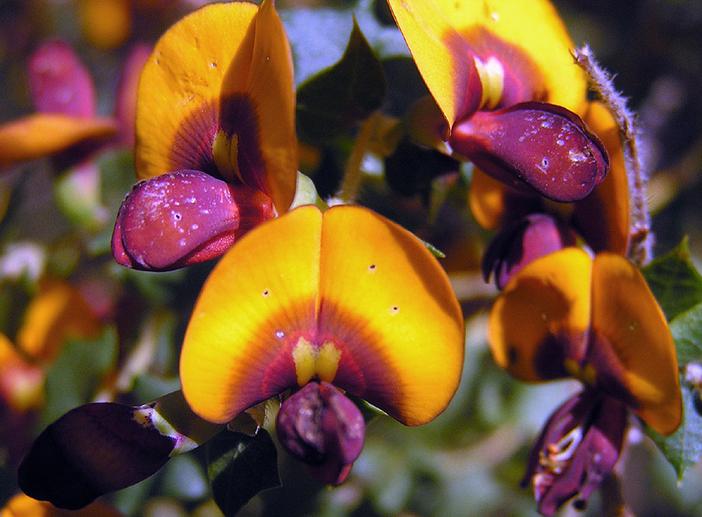Bacon And Eggs
(Eutaxia obovata)
Bacon And Eggs (Eutaxia obovata)
/
/

jmcgross
CC BY 2.0
Image By:
jmcgross
Recorded By:
Copyright:
CC BY 2.0
Copyright Notice:
Photo by: jmcgross | License Type: CC BY 2.0 | License URL: https://creativecommons.org/licenses/by/2.0 | Uploader: Berichard | Publisher: Wikipedia Commons





Estimated Native Range
Summary
Eutaxia obovata, commonly known as Bacon and Eggs, is a perennial shrub native to the sandy soils and granite outcrops of Western Australia’s woodlands and heathlands. It exhibits a moderate growth rate, typically reaching 0.5-3 feet (0.15-0.9 meters) in height and 1-3 feet (0.3-0.9 meters) in width. The plant is characterized by its dense, bushy habit and small, pinnate leaves. During the spring and summer months, Eutaxia obovata produces abundant, pea-like flowers that are yellow with red markings, giving rise to its common names due to their resemblance to eggs with bacon. These flowers are quite showy and attract pollinators such as bees.
In the garden, Bacon and Eggs is valued for its drought tolerance and vibrant floral display, making it an excellent choice for xeriscaping and native plant gardens. It is also used in rockeries and as a low-maintenance ground cover. This shrub thrives in full sun to part shade and prefers sandy or loamy soils with good drainage. It requires minimal water once established, reflecting its adaptation to arid environments. While generally pest-free, it can be susceptible to root rot if overwatered or planted in poorly draining soils.CC BY-SA 4.0
In the garden, Bacon and Eggs is valued for its drought tolerance and vibrant floral display, making it an excellent choice for xeriscaping and native plant gardens. It is also used in rockeries and as a low-maintenance ground cover. This shrub thrives in full sun to part shade and prefers sandy or loamy soils with good drainage. It requires minimal water once established, reflecting its adaptation to arid environments. While generally pest-free, it can be susceptible to root rot if overwatered or planted in poorly draining soils.CC BY-SA 4.0
Plant Description
- Plant Type: Shrub
- Height: 0.5-3 feet
- Width: 1-3 feet
- Growth Rate: Moderate
- Flower Color: Yellow, Red
- Flowering Season: Spring, Summer
- Leaf Retention: Evergreen
Growth Requirements
- Sun: Full Sun, Part Shade
- Water: Low
- Drainage: Fast, Medium
Common Uses
Bird Garden, Butterfly Garden, Drought Tolerant, Low Maintenance, Rock Garden, Showy Flowers
Natural Habitat
Sandy soils and granite outcrops of Western Australia’s woodlands and heathlands
Other Names
Common Names: Common Eutaxia, Egg and Bacon plant
Scientific Names: , Eutaxia obovata,
GBIF Accepted Name: